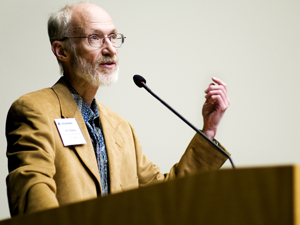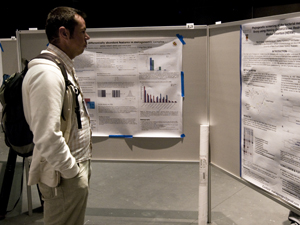International Conference on Metagenomics Seeks to Harness the Power of Microbes to Address World's Challenges
San Diego, CA, Nov. 20, 2008 — About 250 leaders in the emerging science of metagenomics converged at the UC San Diego division of the California Institute for Telecommunications and Information Technology (Calit2) earlier this month for the third Annual International Conference on Metagenomics. The conference was a week-long opportunity to share data and discuss the latest research, explore how advances in computing and sequencing technologies might be of benefit, and build or strengthen collaborations in the field.
|
Metagenomics is a revolutionary approach to microbiology that bypasses the need to culture and clone individual microbe species, instead employing modern computational and analytical techniques to help scientists understand how microorganisms function in their natural ecosystems. To get an idea for how vast the field is, consider that the total number earth's microbes is estimated to be about 10 to the 28th power. By contrast, the estimated number of stars in the known universe is several orders of magnitude lower, at between 10 to the 22nd power and 10 to the 24th power. Wrap your brain around that and you start to comprehend the stunning potential of metagenomics, which is expected to reveal new insights into microbes, one of the planet's most complex life forms, and the complex communities in which they live.
"While experiments in what is today called 'metagenomics' have been conducted for more than two decades, only in the past few years has the potential of metagenomics become obvious to a much wider swath of the biology community," says John Wooley, the founder and primary organizer of the conference and the Chief Scientific Officer of UCSD's cyberinfrastructure project for metagenomics or CAMERA (Community Cyberinfrastructure for Advanced Marine Microbial Ecological Research and Analysis). "The excitement in the field has been solidified by these meetings at UCSD, which feature participants from all over the world."
In traditional genomics studies, researchers isolate particular microbes (individual species) and clone them in a lab to reveal the genetic makeup of a particular species. This method, however, provides little information about how the microbes live in their natural environments; that is, how they interact with each other and with other organisms, or how they function in a specific environment.
It's also becoming increasingly evident that traditional genomic research tends to miss the big picture: Some microbes, for example, might require the products of other microbes to survive, and thus, can't grow in a cultured environment. In other cases, current technical limitations make it impossible to duplicate the complex environments where certain microbes flourish, such as the high-temperature, high-pressure zones found near deep-ocean vents. Surveys of ribosomal genes taken directly from their natural environment reveal that cultivation-based methods find less than 1 percent of the microbial species in a sample, which means that until now, the vast majority of microorganisms has gone unnoticed.
"In the past, we used experimental approaches that were tailored either for cultured microbes or to ask limited questions (such as about relationships or phylogeny) about environmental samples," Wooley muses. "But now, with the convergence of metagenomics and information technology, you don't have to pre-sort a sample of an environmental microbial population. We have powerful computational tools that can sort out the biological information, organize sequence information and mine the data to inform us about the functional consequences of that genetic sequence information. We can now use this knowledge-based approach to ask what impact an environment has on everything from a microbe's productivity and nutritional requirements to the proteins that it makes and in turn, what impact a microbe has on its environment. While these integrated studies are just beginning, they will have a profound impact within this decade on basic biology and its applications."
|
Alexandra Worden, a scientist at the Monterey Bay Aquarium Research Institute and a leading researcher in the metagenomics community, described some of the impacts of the conference.
"I see the quantity of metagenomic data as a challenge, but the ability to integrate different data sets as an even greater challenge. At this meeting you could see a lot of thought going into issues of how to combine approaches and data types, something which is critical for helping metagenomics move from being a gene cataloging activity to an application in hypothesis driven science. For our research on how marine microbes contribute to regulation of earth's atmosphere, data integration — along with greater attention to experimental design (as applied to metagenomic and transcriptomic data collection) — is essential. It will facilitate exploration of, for example, potential 'rules' behind how different microbial communities assemble in the ocean. This will help scientists predict how communities might change under various environmental perturbations, whether natural or man-made."
Harnessing the power of microbial communities might lead to more sustainable energy sources, for example, since certain microbes, when working together as a community, produce a variety of potential energy sources such as hydrogen, methane and even electric current. A metagenomic approach to agriculture could help farmers develop advanced crops or find improved methods for detecting diseases in crops, livestock and food products. By obtaining a better understanding of the microbes that normally inhabit the human body (and there are a lot of them: for every 10 cells in the average human body, nine are microbes), doctors can develop new strategies for diagnosing, treating and preventing disease.
Discoveries in the field of metagenomics could even improve national security: By studying the DNA and biochemical footprints of microbial communities, specialists can expand the range of vaccines that are effective against potential bioterror agents.
It's within the realm of the earth (air, water and soil) and life sciences that the metagenomicists at UCSD and Calit2 have made their greatest impact. The Calit2-based CAMERA, a major driver for the Metagenomics Conference, was initiated in 2006 to serve the needs of the microbial ecology research community by creating a rich data repository that distinguishes itself by going beyond simply sequence data. Additionally, CAMERA provides a suite of bioinformatic tools, allowing researchers to query the data and integrate the information into knowledge.
|
The seven-year, $24.5 million project is funded by the Gordon and Betty Moore Foundation (which is currently sponsoring the sequencing of whole genomes from more than 160 marine microbes). CAMERA is also working closely with the Genome Standards Consortium (GSC), which is leading a community effort to establish a richer, more standardized description of the world's collection of genomes and metagenomes. The GSC is also focused on ensuring standards for collecting the secondary data (metadata) about the samples used, such as environmental and ecological information. The metadata permits researchers to probe the information in CAMERA's knowledge base, allowing sequence and environmental information to be integrated to answer significant challenge questions in microbial ecology.
Since the CAMERA project began, it has grown to serve more than 2,400 users from over 450 institutions in more than 50 countries, with approximately half of those users coming from outside the U.S. Wooley notes at least half of the participants who attend the Metagenomics Conference each year are "routine and regular users" of the CAMERA cyberinfrastructure, and most of the other participants have downloaded files from CAMERA for use in their own computing infrastructures.
"The 'C' in CAMERA stands for both community and cyberinfrastructure," notes Larry Smarr, director of Calit2 and CAMERA's principal investigator. "A major goal in the creation of the CAMERA project was for Calit2 to act as a catalyst for bringing the emerging global metagenomics community together to drive rapid scientific advances. Having all these world experts here giving lectures and engaging in discussions enables the CAMERA project to gain deeper insights into this rapidly changing science, as well as to understand the needs of the community."
The rapidly increasing body of data related to metagenomics is being driven by advances in ultra high-throughput (next-generation) genetic sequencing technologies, as well as an increasing demand for the ability to link different types of data (genomes with proteins, for example). Paul Gilna, a member of the CAMERA leadership team, says the CAMERA project, among other objectives, was conceived to meet the needs of the research community in handling the increased volume of data production, from large-scale sequencing labs to single-machine labs.
|
Wooley remarks that the rapid growth of metagenomics has been enabled by the parallel revolutions in sequencing technology and information technology.
"We captured elements of both of these revolutions at this year's Metagenomics conference," he notes, "and although the three meetings we've had to date have particularly represented the advances in marine microbiology and other environmental studies in metagenomics such as those of soil and fresh water microbial populations, we've remained aware of the breadth of new science coming from metagenomic studies. From our understanding of primary productivity in the ocean and the genetic structure of microbial communities, for example, will come a deeper understanding of evolution and the relationship of organisms, as well as the potential of applications in areas like bioenergy, carbon sequestration, bioremediation, and human well-being and disease. New academic and commercial efforts in synthetic biology and synthetic genomics are already poised to develop such applications."
"In addition to the range of experimental biologists studying metagenomics," he continues, "we include participation by numerous software developers, infrastructure and technology providers and knowledge-based curators. By addressing the challenges in next-generation sequencing, as well as unique attributes of metagenomics that require new computational approaches — software, algorithms and user-friendly packages — we can reflect the numerous complexities of metagenomics that lie beyond more traditional genomic studies."
Jack Gilbert, a leading research in marine metagenomics and metatranscriptomics and a professor at Plymouth Marine Research Laboratory in the UK, notes: "Increased exposure of metagenomics research will have an impact in shaping the direction and the development of the science. Including the idea of genomic standards by the GSC was significantly interesting, also, and these standards will have a bit impact. CAMERA, the best system the community has, contributes as a premier presenter of high quality projects and by bringing together research groups from around the world for exciting presentations and formal and informal discussions at the annual conference. I am particularly excited, given my own efforts, in metatranscriptomics, and in the development of this domain in conjunction with other 'meta-science,' for example, metaproteomics."
In sum, Wooley concurs with the assertion by the National Resource Council (NRC), which has called the science of metagenomics "a quantum leap forward in microbiology analogous to the revolutionary new view offered by the first microscope."
"Microbes rule the world," adds Mark Ellisman, chief technology officer of CAMERA and UC San Diego professor of neuroscience, in quoting an NRC study. "The invention of the microscope allowed us to see previously invisible organisms and to begin to recognize many phenomena going on that had previously been outside human detection. In a way, such novel observation was a step toward bringing the physical sciences and the world of biology together to probe the details of living cells. Going beyond clonal culture, metagenomics once again opens up such vast horizons, beginning with access to study the 99 percent or more of microbes that have never been cultured before."
Related Links
Annual International Conference of Metagenomics
CAMERA
Media Contacts
Tiffany Fox, (858) 246-0353, tfox@ucsd.edu




